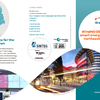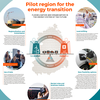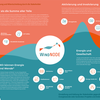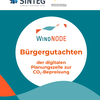The Second Phase of the Energy Transition
In the future, our electricity demand should be covered almost entirely by renewable sources. To this end, renewable energy was developed on a wide scale in Germany during the “first phase of the energy transition”. This development should be constantly intensified even further. At the same time, the integration of renewable energy into the energy system presents new and significant challenges, which will be the object of the “second phase of the energy transition”.
Grid Expansion... And What Comes Next?
Today, one third of the electricity in Germany is already provided by “renewables”, mainly wind and solar power. This is much more than even optimists had hoped for a few years ago. However, what does “one third of renewables” mean? This is actually an average, calculated over the entire year, as sun and wind are volatile energy sources that only intermittently supply energy depending on wind and weather. On windless nights (the so-called ‘dark doldrums’), there is almost no green power, so that coal- and gas-fired power stations have to help out. During sunny, windy days, by contrast, wind and solar power stations may generate a lot more electricity than is actually required in certain regions.
High Tension on the Grid
In the transmission and distribution grids, which bring green power to urban and industrial consumers, there is a risk of overloads when there is a considerable supply of renewable energy. In part, these are so significant that the generation from wind and solar power plants have to be curtailed, i.e. reduced. These interventions by the system operators are called generation management. In these cases, the full potential of renewable energy remains untapped. This is not only an ecological but also an economic problem.
For the further growth of renewable energy, we therefore need to answer the question of how the generated renewable energy can be made available at the right place at the right time. This so-called system integration of renewable energy is the decisive challenge during the second phase of the energy transition.
All a Matter of Balance
To ensure that the power grid remains stable, the electricity supply and demand have to be balanced at all times. This principle is as old as electricity supply itself. New, however, is that wind and sun (contrary to coal- and gas-fired power plants but also other renewable sources such as biogas) cannot be adjusted and do not respond to consumer demand. Then how can the users’ consumption of electricity be coordinated optimally with the fluctuating generation and how can the grids be kept stable? It is exactly this question that the more than 70 project partners from north-eastern Germany seek to answer by working together in the WindNODE project.
The Smart Grid is Flexible
In addition to the required grid development, an important part of the answer is: flexibility. Anyone who has ever booked a holiday trip knows the principle. If you are flexible and can plan your trip during a period when few other people are travelling, you can benefit from the most favourable hotel rates. In the power grid as well, we look for flexible customers who can literally adjust their electricity consumption to the weather forecast and save money in return. For instance, a factory can plan part of its production in a period when a powerful wind front is expected to pass over the country. A supermarket can cool its freezers ‘in advance’, so that the products also remain sufficiently cold, even when the cooling units remain inactive during subsequent low wind periods.
The WindNODE Approach
At WindNODE, we systematically search for such flexibility in industry, commerce and residential areas and study how it can be activated and managed.
In order for the participants to know when the time is right to consume electricity, we are working on an innovative platform on which they can offer their flexibility. Electricity system operators can activate the flexibilities offered there and use them in such a way that overloading the power grids can be avoided at the lowest possible cost and as much renewable power as possible is used.
That is why we at WindNODE are working on storage solutions with large batteries in order to store more excess electricity. And last but not least, we are developing applications for so-called sector coupling, i.e. a stronger use of (renewable) electricity in the traffic (electromobility) and heating (Power-to-Heat) sectors. This way, more fossil fuels (coal, oil, natural gas) can also be replaced by renewable electricity (so-called decarbonisation).
Further Information
Information material

2 MB 10.04.2018 pdf

652 KB 10.04.2018 pdf

Poster zu Partizipation und Akzeptanz (German only)
922 KB 10.11.2020 pdf

4 MB 16.12.2020 pdf





